This article was published in Scientific American’s former blog network and reflects the views of the author, not necessarily those of Scientific American
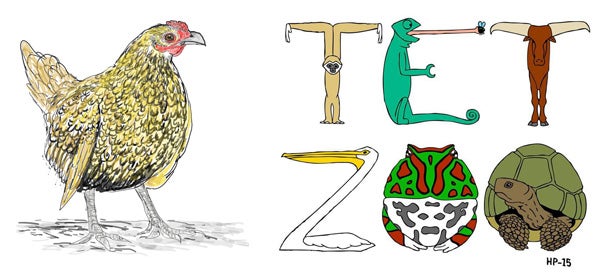
At top: Flame, the bearded dragon - she's about 2 years old. Above left: Seebright chicken by Darren Naish. Above right: Tet Zoo graphic by Henrik Petersson.
I figured that this event should be marked in some way that’s different from usual. Combine it with the fact that my annual reviews always tend to be over-long and that I’m over-committed and unable to find time for blog-writing this month anyway, and the result is… a whole month dedicated to 10 years of Tet Zoo. If this quantity of gratuitous introspection and self-congratulation is too retchingly egoistic for you to handle, go away and check back next month. It’s a big deal for me and I can’t ignore it.
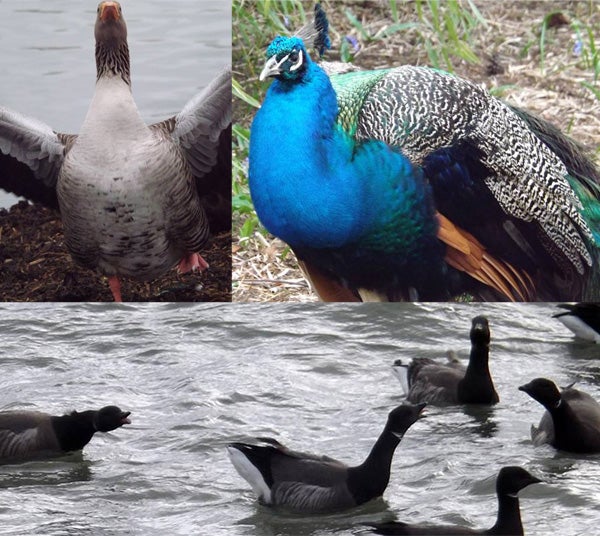
Some galloanserines of 2015: Greylag Anser anser, Peacock Pavo cristatus, Brent or Brant geese Branta bernicla. Photos by Darren Naish.
On supporting science journalism
If you're enjoying this article, consider supporting our award-winning journalism by subscribing. By purchasing a subscription you are helping to ensure the future of impactful stories about the discoveries and ideas shaping our world today.
Here’s how the whole thing is going to pan out. To begin with, I’m going to review the events and adventures of 2015. I’m then going to review the blog’s taxonomic coverage during 2015. This is the part where I beat myself up for not writing enough about amphibians and turtles and berate myself for being too focused on charismatic megafauna. And then I’ll finish things by musing about the role of Tet Zoo in the blogosphere. Some of this might be interesting, but at least there’ll be lots of pictures. To work.
2015 the early months
Some things were due to happen in 2015. The writing of two… three… four books. More fieldwork in Romania. Four conferences in the UK, all of which I was (in some way) involved with, assorted technical research projects, continual progress at the Tet Zoo patreon project (THANK YOU PATRONS!) and the TetZoopodcats podcasts…
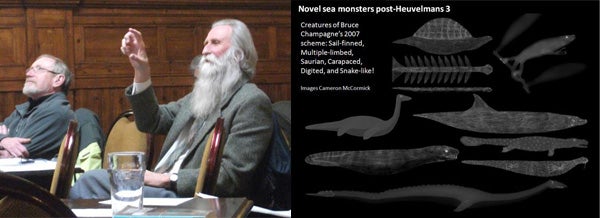
At left: Adrian Shine holds the floor at the SRA meeting. At right: montage depicting Cameron McCormick's renditions of a selection of sea monsters, from my SRA sea monsters talk.
During February I attended (and spoke at) the SRA (= Scholarly Research of the Anomalous) conference in Edinburgh, Scotland. As I’m sure you already know, there’s a lot of science to do on anomalous phenomena no matter whether there’s validity in them or not – human belief systems, our perceptive abilities, the way we interpret data, ideas, concepts and so on are all rewarding areas of study regardless of whether sea monsters, bigfoot or UFOs exist. Highlights included Roger Musson on the Bala earthquake – yes, this is the same event as the Berwyn Mountain UFO incident – Bettina Bildhauer on monster beliefs of the Middle Ages, Mike Dash’s ‘Our Artist Pictures What the Witness Saw’ and Charles Paxton on eyewitness reliability and re-enactments of the Patterson film. My own talk was on the evolution of ideas about sea monsters: I’d talk more about it, but now is not the time and I think it’s covered in my new cryptozoology book anyway (on which more later). Thanks to Gordon Rutter and Charles Paxton for the invitation and for organising a great conference.

Scenes from Edinburgh Zoo. Clockwise from top left: Visayan spotted deer Rusa alfredi, evil Drop bear Thylarctos plummetus, snoozing Giant panda Ailuropoda melanoleuca, artwork depicting anthropoid primate phylogeny (anyone know the name of the artist?). Photos by Darren Naish.
I took advantage of my time in Edinburgh to visit the zoo. Bad weather (driving rain) meant that it wasn’t the best of outdoor experiences I’ve had, but at least I had close-up views of such animals as giant panda, binturong (yeah, sleeping), one-horned rhino, drill, douroucouli and cassowary.
March saw the publication of a collaborative paper on a small azhdarchid pterosaur vertebra from Romania (Vremir et al. 2015). This is a significant specimen since it provides evidence for a new, small, relatively short-necked azhdarchid taxon that lived alongside the also small but long-necked Eurazhdarcho and the gigantic Hatzegopteryx. Incidentally, the published version of this paper does not reflect the look or feel of previous drafts – I’m not happy with the very text-heavy look of the final product… pages and pages of text and nothing else.
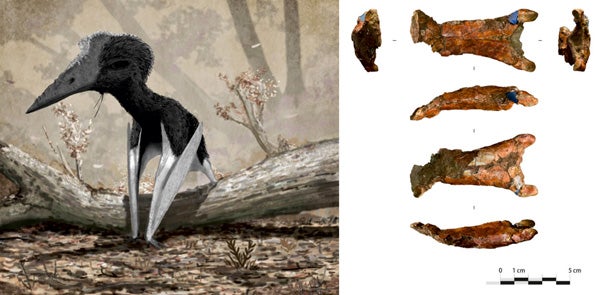
At left: Mark Witton's speculative reconstruction of the robust-necked Romanian azhdarchid represented only by the cervical vertebra R.2395, described in Vremir et al. (2015). We did so much other work on azhdarchids during 2015...
A few other interesting things happened in March. I started work on a new dinosaur-themed book (co-authored with Paul Barrett of The Natural History Museum, London), caught up (briefly) with Steve Backshall while attending a talk he gave for the Winchester College Natural History Society, and went to a talk by Christine Janis on kangaroo anatomy. And I was absolutely thrilled to receive a review copy of Gordon Grigg and David Kirshner’s incredible Biology and Evolution of Crocodylians (Grigg & Kirshner 2015), one of the most significant zoological books of our time. My initial thoughts on the book are here and I still have to write a proper, long review for publication. By the end of March, I’d done enough work on The Big Book (aka The Vertebrate Fossil Record) to have another draft ready for sharing and viewing. I suppose at this stage that the book was over 50% complete. Already it was 553 pages long.
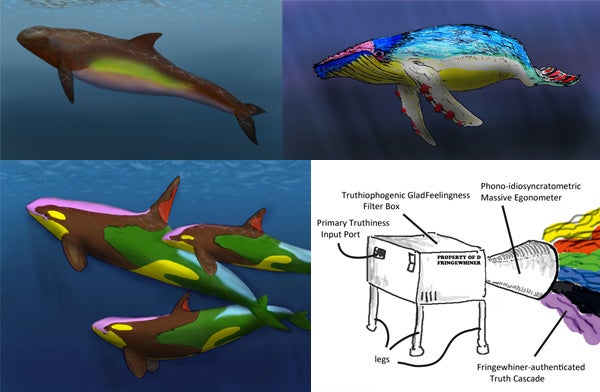
Our knowledge of cetaceans changed dramatically in 2015. Article here. Illustrations by Darren Naish and Gareth Monger.
April started with the pivotal Tet Zoo article on how the Chromatic Truthometer has shown the world that cetaceans are not the blacks, grey and browns so often assumed but, actually, multi-coloured beasts of many hues. I was in Romania at the time, doing fieldwork. I saw European bison Bison bonasus (captive, not wild), Syrian woodpecker Dendrocopus/Picoides syriacus, Valachian sheep (article here) and much else, and my colleagues and I succeeded in finding new Cretaceous dinosaur and pterosaur specimens.
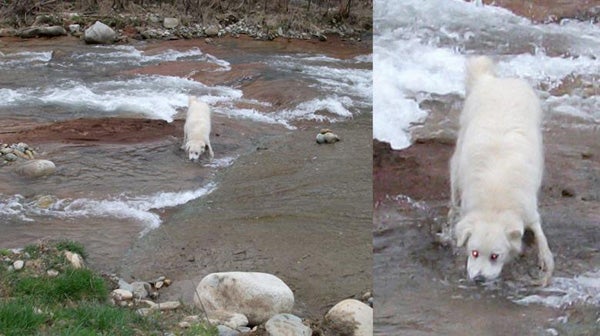
A giant white water-hound, eyes ablaze, encountered in Romania. Photos by Darren Naish.
The Hoser Issue Once More
Regular readers will be aware of the effort to minimise the vigorous taxonomic vandalism being practised by independent researcher and snake-keeper Raymond Hoser – I covered this issue at length back in June 2013. Hoser has named hundreds of new, or allegedly new, taxa (including ‘higher’ entities like subfamilies, families and so on) and wants his names to be accepted by the technical community. There are a whole list of reasons why this shouldn’t happen: not only are the names etymological monstrosities, they’re published in-house in a desktop magazine that can’t be considered at all acceptable in terms of technical standards.
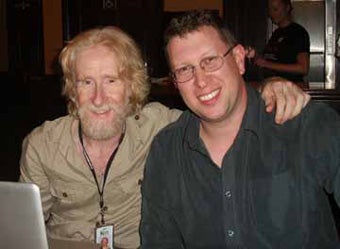
Proof that I'm a member of the 'Truth Haters' club: me (at right) with herpetologist Mark O'Shea (photo from August 2012). E. O. Wilson, Colin Groves and at least 58 other professional biologists are members of this little group as well.
There have been several efforts over the years to get Hoser’s hundreds of proposed names stricken from the record. Unfortunately, the body that’s supposed to police and monitor taxonomic problems and disputes (the ICZN, the International Commission on Zoological Nomenclature) simply won’t make rulings on situations of this sort on its own. Instead, communities of workers are required to resolve messes for themselves before steering the ICZN toward the making of an appropriate final decision. And so it was that a large number of people interested in the Hoser problem ganged together in order to encourage the ICZN to have Hoser’s primary taxonomic vehicle (his Australian Journal of Herpetology) listed as unavailable for the publication of new taxonomic names.
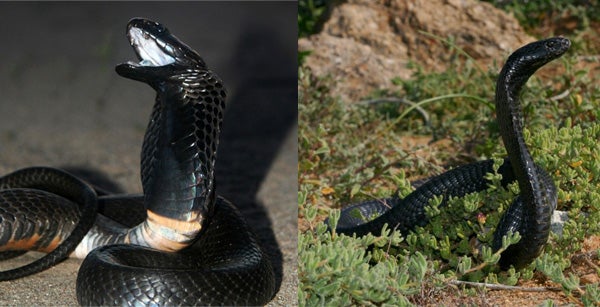
Cobras of the subgenus Afronaja Wallach et al., 2009. A. nigricollis at left (photo by Warren Klein, CC BY-SA 3.0); A. nigricincta at right (photo by Wolfgang Wüster, used with permission). Hoser published the name 'Spracklandus' for the same taxon in 2009, and hence we have ICZN Case 3601.
The resulting paper – led by Anders Rhodin and involving Roger Bour, Frank Glaw, Colin Groves, Russell Mittermeier, Mark O’Shea, James Parham, Robert Sprackland, Laurie Vitt, E. O. Wilson, Hussam Zaher, myself and many others – was published in March (Rhodin et al. 2015). The aim of publishing an argument such as this is to solicit comments from other members of the community, the weight of consensus then affecting the ICZN’s eventual ruling. It’s Case 3601 and comments can be added here.
Hoser is a perfectly sensible and normal individual. Just to prove this, he recently went through my entire twitter feed to find – and respond to – all the mentions of his good self. I’ll be covering the Hoser issue again at some point.
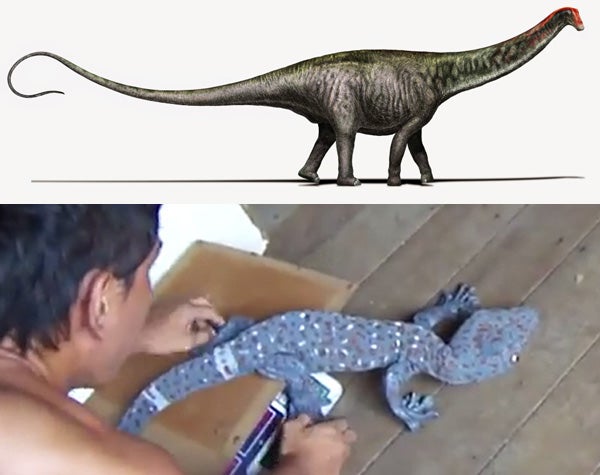
Two topics featured on Tet Zoo during April 2015: Brontosaurus (image at top by Davide Bonadonna), and the modification of live monitor lizards into giant geckos.
Tapirs, Membranous-Winged Maniraptorans, Lyme Regis and More
The multi-author article denouncing the pterosaurian nature of ‘Thalassodromeus sebesensis’ – it’s actually a partial plastron of the turtle Kallokibotion – saw print in April (Dyke et al. 2015). April also saw Tet Zoo articles on Brontosaurus, on the artisan modification of live monitor lizards (thanks to Memo Kosemen for all his help with that), and my article Some of the Things I Have Gotten Wrong. I mean to do follow-up articles to that one: there are, you see, an awful lot of Things I Have Gotten Wrong, but I haven’t yet found the time. Remember: it’s normal to get things wrong, and there’s absolutely nothing wrong with that so long as you aim to change your mind and admit your mistakes the more you learn. April 27th was World Tapir Day, and I hastily covered it on Tet Zoo. I like tapirs. Did I mention that there’s a new one? This wasn’t the only perissodactyl-themed day of 2015.
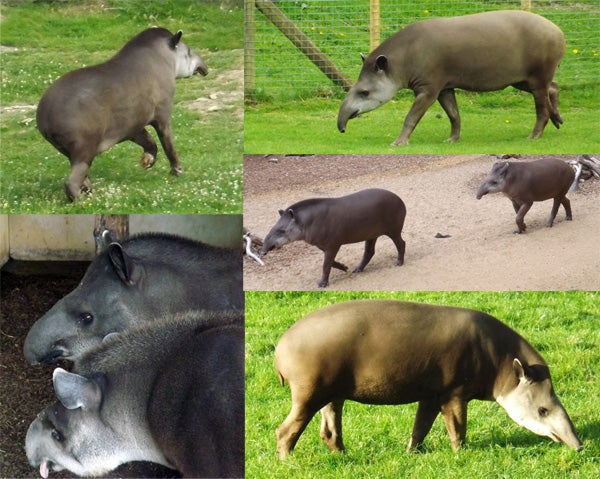
Tapirs of 2015. These are all Brazilian or Lowland tapirs Tapirus terrestris, mostly photographed at Marwell Wildlife. The animals at lower left live at Chester Zoo. Photos by Darren Naish.
The bizarre new membranous-winged maniraptoran dinosaur Yi qi was published late in April and the Tet Zoo take on it proved one of the year’s most popular articles. As I said back then, some of the most interesting things about Yi qi weren’t really covered by other writers or scientists. One is that the possible existence of membranous-winged scansoriopterygids was predicted and in fact even published (in All Your Yesterdays) years prior to 2015. Another is that the ‘screaming dragon of death’ images so prevalent online probably do not accurately reflect what we know about the life appearance of this animal. It probably looked more like a bat-winged parrot.
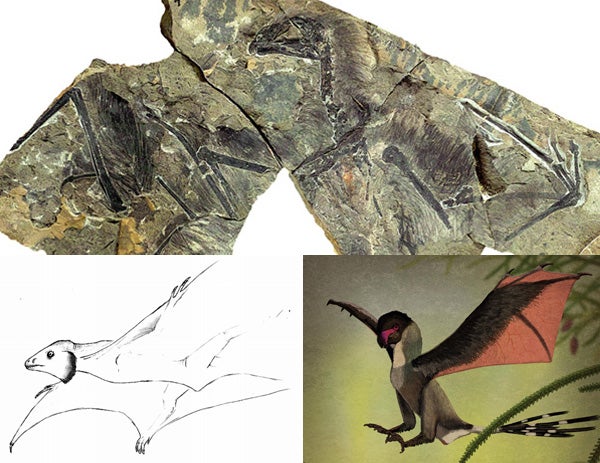
At top, the Yi qi holotype. Lower left: one of (at least) two predicted membranous-winged scansoriopterygid reconstructions that appeared in print before Yi qi did. This one is by Andrea Gassler and appeared in the book All Your Yesterdays. Non-dragonesque reconstruction of Yi qi by John Conway.
As has been tradition for the past few years, I and colleagues attended the Lyme Regis Fossil Festival during late April and early May. We spoke to people about Mesozoic marine reptiles, dinosaurs and other beasts. I spent time at the coast, photographing pipits, wagtails, pigeons and gulls, as is tradition. I wrote about the pigeons.
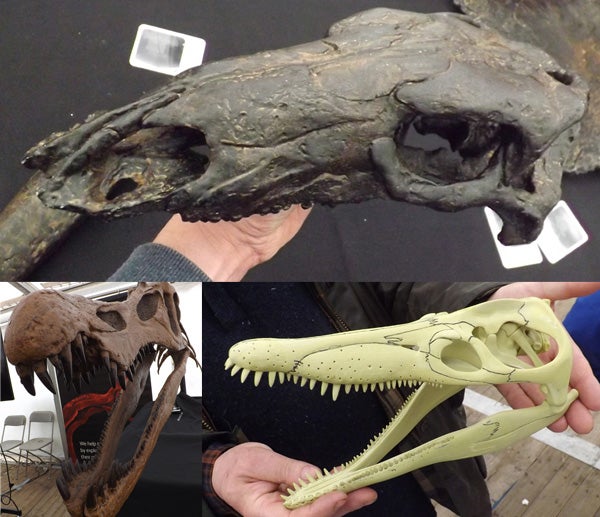
Replica skulls of the 2015 Lyme Regis Fossil Festival. At top, Sophie the stegosaur from the NHM stand. Lower left: that Baryonyx skull replica again. Lower right: Andrew Cock's Pliosaurus kevani skull model (here held by Richard Forrest). Photos by Darren Naish.
Significant progress was made on several technical projects during May: on a sauropod-themed manuscript, an azhdarchid one that’s kind of a big deal, and another that involved reinterpreting the Romanian maniraptoran Balaur. I’m sure I’ll mention again that 2015 was one of the most frustrating years I’ve yet endured in that an incredible number of technical papers got to a very advanced stage in the long and tedious process of publication, only to stall or be derailed for one reason or another. Of the projects just listed, only one has made it to completion so far. Such is the nature of the beast when it comes to scientific publishing, but it doesn’t ever make it any easier, especially not when you have to pour your own hard-won free time – or have to take time away from paid work – into getting things done.
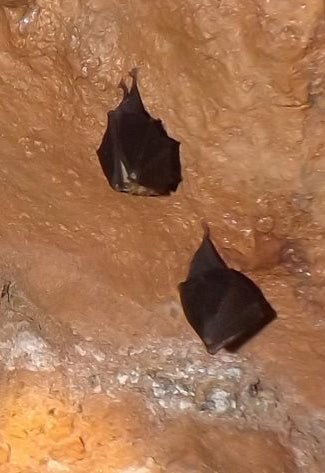
Lesser horseshoe bats Rhinolophus hipposideros in a cave roost. This bat is at the edge of its range in the UK and only occurs in Wales and in western and south-western England. Photo by Darren Naish.
While staying in north Wales in May, I (and my family) visited both Chester Zoo and the Welsh Mountain Zoo. At both of these fine zoos I did see a great many animals, some of which you can see here. While caving, I (and my son, Will) accidentally discovered a Lesser horseshoe bat colony. Disturbing a bat roost is a criminal offence here in the UK, but of course this only counts when people know that there’s a bat colony there in the first place. Rest assured that we acted in proper fashion.
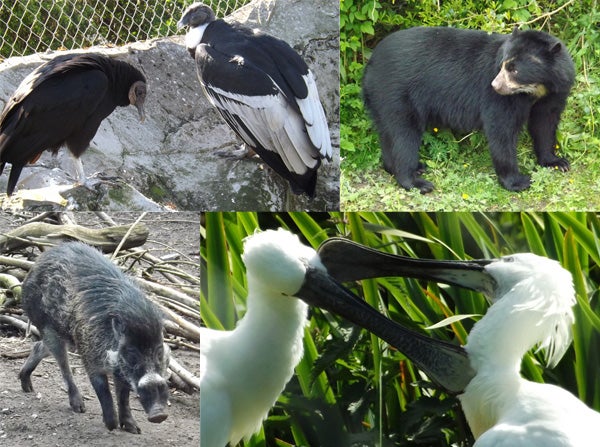
Scenes from Chester Zoo. Clockwise from top left: American black vulture Coragyps atratus and Andean condor Vultur gryphus, Spectacled bear Tremarctos ornatus, allopreening Eurasian spoonbills Platalea leucorodia, Visayan warty pig Sus cebifrons. Photos by Darren Naish.
A Little Movie Called Jurassic World
June at Tet Zoo started with an article about turtles. Ah, turtles. I really need to blog about them a whole lot more. Sorry turtles. The final proofs for the paper version of Witton & Naish (2015) were dealt with – another azhdarchid paper... (a digital preprint has been around since 2013).
Of course, June was also the month in which a movie called Jurassic World was released. Like everyone else who works on Mesozoic dinosaurs, journalists sought me out for my opinion (I penned an opinion piece for CNN). I don’t rate Jurassic World at all. It’s a dumb film with a lazy storyline, it makes a point of poking fun at you if you have any affection for Jurassic Park, and it deliberately gives us hideous monsters because modern audiences only like dinosaurs, apparently, when they look like saggy-skinned throwbacks from the 1950s. I agree with whomever it was that compared ‘Indominus’ to Rudy from Ice Age 3: Dawn of the Dinosaurs.
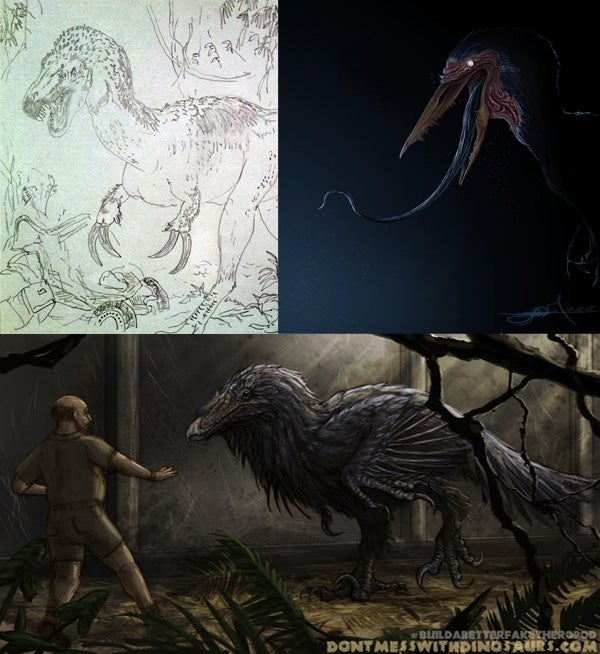
Some #BuildABetterFakeTheropod theropods. Top right image by Jack Mayer Wood. Image below by Brian Engh.
During May I’d already been quoted in the Sunday Times, the Mirror and various other UK papers, my primary lament being that Jurassic World simply could have been so much better as goes an innovative portrayal of Mesozoic animals. But, no. Stick with what’s safe. Cowards. The same sentiments were reflected via Brian Engh’s Build A Better Fake Theropod project, mentioned on Tet Zoo during June.
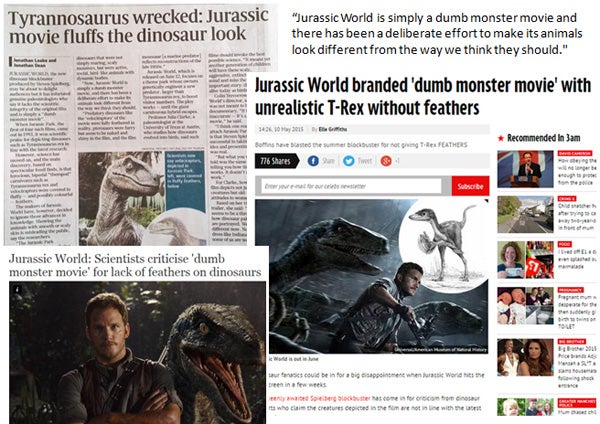
And that’s where we’ll end things for now. More thoughts coming soon.
For the previous Tet Zoo birthday articles, see...
Refs - -
Grigg, G. & Kirshner, D. 2015. Biology and Evolution of Crocodylians. Comstock Publishing Associates and CSIRO Publications.